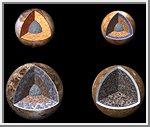|
COMETS EARTH JUPITER KUIPER BELT MARS MERCURY METEORITES NEPTUNE OORT CLOUD PLUTO SATURN SOLAR SYSTEM SPACE SUN URANUS VENUS ORDER PRINTS
PHOTO CATEGORIES SCIENCEVIEWS AMERICAN INDIAN AMPHIBIANS BIRDS BUGS FINE ART FOSSILS THE ISLANDS HISTORICAL PHOTOS MAMMALS OTHER PARKS PLANTS RELIGIOUS REPTILES SCIENCEVIEWS PRINTS
|
Related Document
Download Options
These cutaway views show the possible internal structures of the Galilean satellites. Io is at the top left, Europa is at the top right, Ganymede is at the bottom left, and Callisto at the bottom right. The satellites are shown at their relative correct sizes. Io has a radius of 1,821 kilometers which is slightly smaller than the moon at a radius of 1738 kilometers. Europa's radius is 1,565 kilometers, Ganymede's radius is 2634 kilometers, and Callisto's radius is 2403 kilometers. The surfaces of the satellites were derived from image data taken by NASA's Voyager and Galileo spacecrafts. The interior characteristics are inferred from gravity field and magnetic field measurements taken by the Galileo spacecraft. With the exception of Callisto, all the satellites have metallic (iron, nickel) cores (shown in gray) drawn to the correct relative size. Again, with the exception of Callisto, all the cores are surrounded by rock shells. Io's rock or silicate shell extends to the surface, while the rock layers of Ganymede and Europa (drawn to correct relative scale) are in turn surrounded by shells of water in ice or liquid form (shown in blue and white and drawn to the correct relative scale). Callisto is shown as a relatively uniform mixture of comparable amounts of ice and rock that extends up to a possible salty ocean (shown in blue) beneath a thick icy crust (shown in white). The surface layers of Ganymede and Callisto are shown as white to indicate that they may differ from the underlying ice/rock layers in a variety of ways including, for example, the percentage of rock they contain. The white surface layer on Europa could have similar significance, although it could also suggest an ice layer overlying a liquid water ocean. Galileo images of Europa suggest that a liquid water ocean might now underlie a surface ice layer several to ten kilometers thick; however, this evidence is also consistent with the existence of a liquid water ocean in the past. It is not certain if there is a liquid water ocean on Europa at present. |
||||||||||||||||||||||||||||||||||
